MMS714 Deakin Uni: Cricket Australia Case Study - Org Behaviour
VerifiedAdded on 2023/06/08
|24
|7521
|401
Case Study
AI Summary
This report provides an overview of sports organization behavior within Cricket Australia, focusing on key issues identified by Integrity Manager Patrick Murphy. It examines problems within the Integrity Unit, staffing, diversity, player conduct, and intern treatment. A culture audit is conducted, highlighting ethical considerations and instances of good ethical practices in sports. The report concludes by proposing strategies to the Board of Directors for organizational culture renewal, supporting Cricket Australia's vision. Key areas covered include the hierarchical structure, lack of diversity, harassment issues, and the impact of past players on the organization's culture and productivity. The analysis aims to assist Cricket Australia in addressing these challenges and fostering a more ethical and inclusive environment.
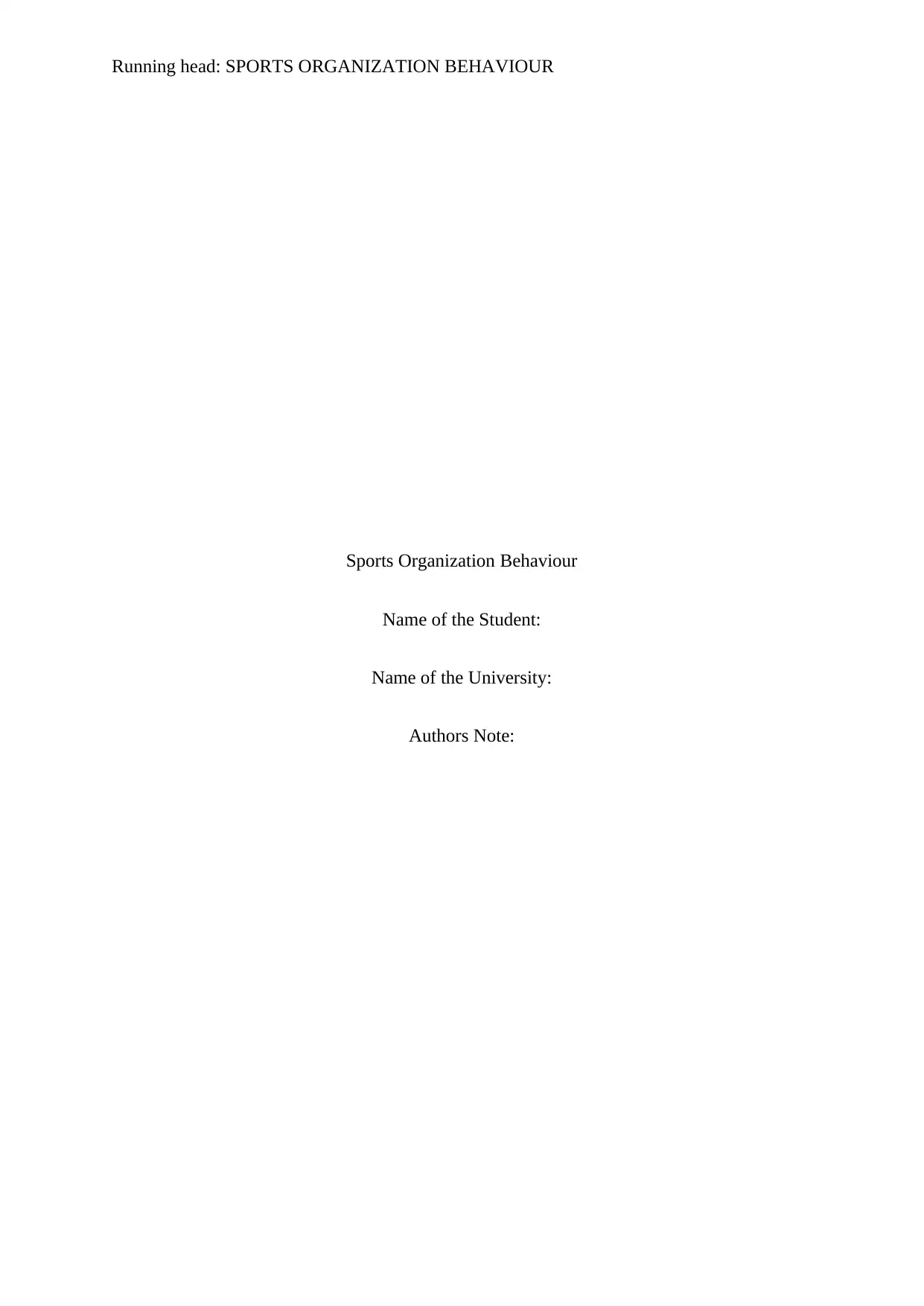
Running head: SPORTS ORGANIZATION BEHAVIOUR
Sports Organization Behaviour
Name of the Student:
Name of the University:
Authors Note:
Sports Organization Behaviour
Name of the Student:
Name of the University:
Authors Note:
Paraphrase This Document
Need a fresh take? Get an instant paraphrase of this document with our AI Paraphraser
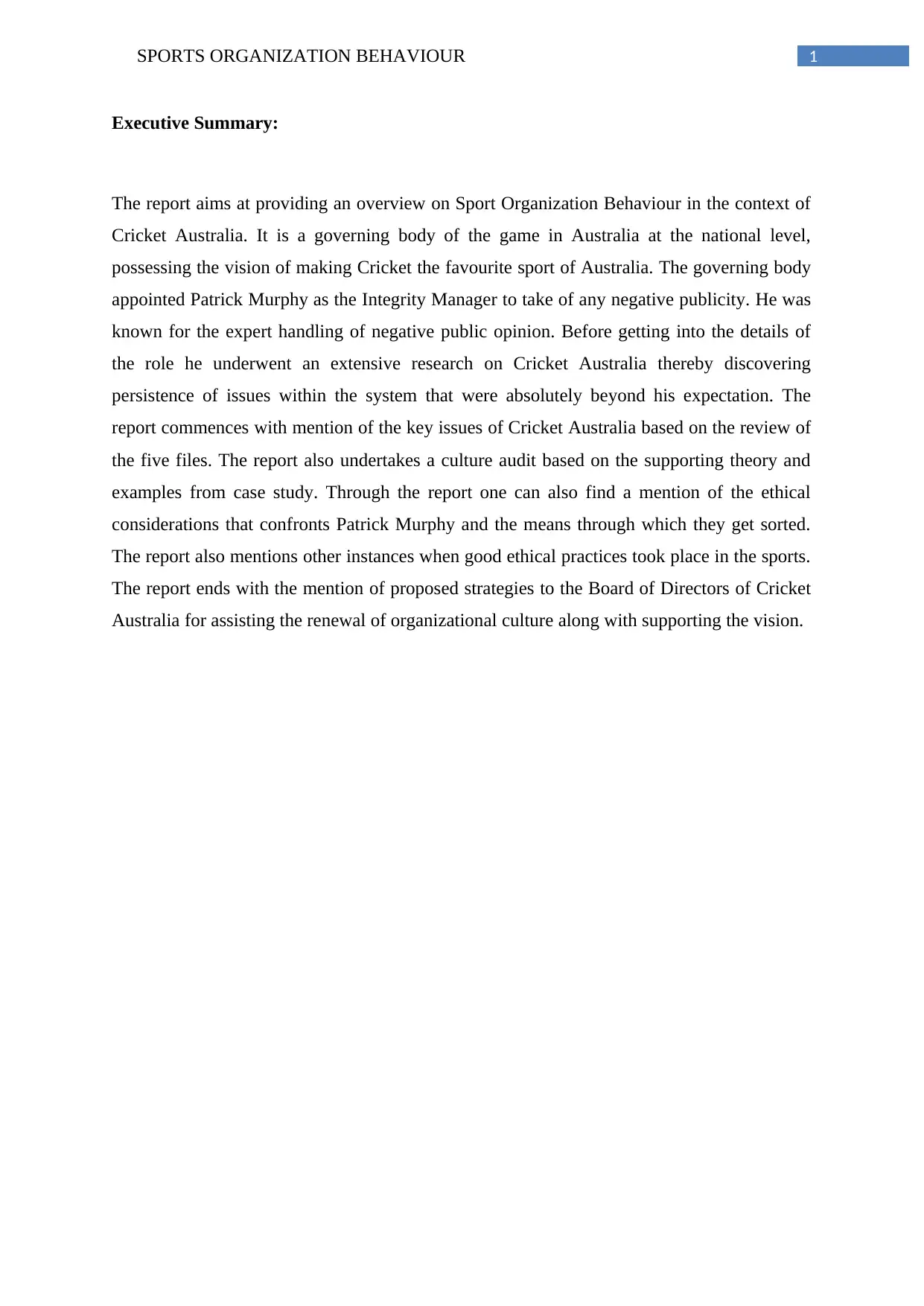
1SPORTS ORGANIZATION BEHAVIOUR
Executive Summary:
The report aims at providing an overview on Sport Organization Behaviour in the context of
Cricket Australia. It is a governing body of the game in Australia at the national level,
possessing the vision of making Cricket the favourite sport of Australia. The governing body
appointed Patrick Murphy as the Integrity Manager to take of any negative publicity. He was
known for the expert handling of negative public opinion. Before getting into the details of
the role he underwent an extensive research on Cricket Australia thereby discovering
persistence of issues within the system that were absolutely beyond his expectation. The
report commences with mention of the key issues of Cricket Australia based on the review of
the five files. The report also undertakes a culture audit based on the supporting theory and
examples from case study. Through the report one can also find a mention of the ethical
considerations that confronts Patrick Murphy and the means through which they get sorted.
The report also mentions other instances when good ethical practices took place in the sports.
The report ends with the mention of proposed strategies to the Board of Directors of Cricket
Australia for assisting the renewal of organizational culture along with supporting the vision.
Executive Summary:
The report aims at providing an overview on Sport Organization Behaviour in the context of
Cricket Australia. It is a governing body of the game in Australia at the national level,
possessing the vision of making Cricket the favourite sport of Australia. The governing body
appointed Patrick Murphy as the Integrity Manager to take of any negative publicity. He was
known for the expert handling of negative public opinion. Before getting into the details of
the role he underwent an extensive research on Cricket Australia thereby discovering
persistence of issues within the system that were absolutely beyond his expectation. The
report commences with mention of the key issues of Cricket Australia based on the review of
the five files. The report also undertakes a culture audit based on the supporting theory and
examples from case study. Through the report one can also find a mention of the ethical
considerations that confronts Patrick Murphy and the means through which they get sorted.
The report also mentions other instances when good ethical practices took place in the sports.
The report ends with the mention of proposed strategies to the Board of Directors of Cricket
Australia for assisting the renewal of organizational culture along with supporting the vision.

2SPORTS ORGANIZATION BEHAVIOUR
Table of Contents
Introduction:...............................................................................................................................3
Discussion:.................................................................................................................................4
1. Main Issues of Cricket Australia............................................................................................4
2. Culture Audit of Cricket Australia through Examples and Supporting Theory.....................8
3. a. Ethical Considerations Confronting Patrick and the Ways of addressing them..............11
b. Instances of Good Ethical Practices in Sport:......................................................................14
4. Strategies Proposed to Board of Directors for Organizational Culture Renewal in Australia
..................................................................................................................................................16
Conclusion:..............................................................................................................................19
References:...............................................................................................................................20
Appendices:..............................................................................................................................20
Table of Contents
Introduction:...............................................................................................................................3
Discussion:.................................................................................................................................4
1. Main Issues of Cricket Australia............................................................................................4
2. Culture Audit of Cricket Australia through Examples and Supporting Theory.....................8
3. a. Ethical Considerations Confronting Patrick and the Ways of addressing them..............11
b. Instances of Good Ethical Practices in Sport:......................................................................14
4. Strategies Proposed to Board of Directors for Organizational Culture Renewal in Australia
..................................................................................................................................................16
Conclusion:..............................................................................................................................19
References:...............................................................................................................................20
Appendices:..............................................................................................................................20
⊘ This is a preview!⊘
Do you want full access?
Subscribe today to unlock all pages.

Trusted by 1+ million students worldwide
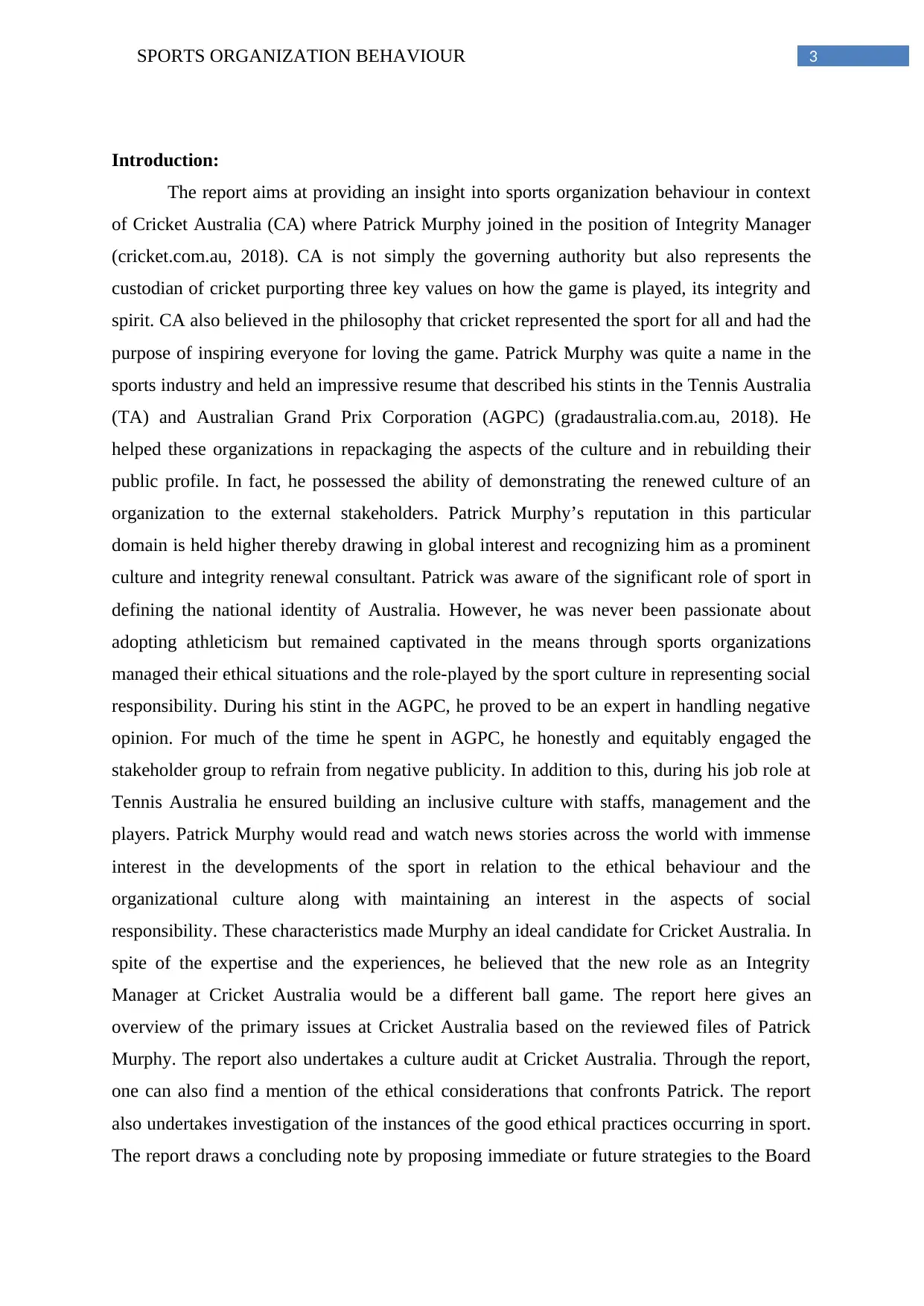
3SPORTS ORGANIZATION BEHAVIOUR
Introduction:
The report aims at providing an insight into sports organization behaviour in context
of Cricket Australia (CA) where Patrick Murphy joined in the position of Integrity Manager
(cricket.com.au, 2018). CA is not simply the governing authority but also represents the
custodian of cricket purporting three key values on how the game is played, its integrity and
spirit. CA also believed in the philosophy that cricket represented the sport for all and had the
purpose of inspiring everyone for loving the game. Patrick Murphy was quite a name in the
sports industry and held an impressive resume that described his stints in the Tennis Australia
(TA) and Australian Grand Prix Corporation (AGPC) (gradaustralia.com.au, 2018). He
helped these organizations in repackaging the aspects of the culture and in rebuilding their
public profile. In fact, he possessed the ability of demonstrating the renewed culture of an
organization to the external stakeholders. Patrick Murphy’s reputation in this particular
domain is held higher thereby drawing in global interest and recognizing him as a prominent
culture and integrity renewal consultant. Patrick was aware of the significant role of sport in
defining the national identity of Australia. However, he was never been passionate about
adopting athleticism but remained captivated in the means through sports organizations
managed their ethical situations and the role-played by the sport culture in representing social
responsibility. During his stint in the AGPC, he proved to be an expert in handling negative
opinion. For much of the time he spent in AGPC, he honestly and equitably engaged the
stakeholder group to refrain from negative publicity. In addition to this, during his job role at
Tennis Australia he ensured building an inclusive culture with staffs, management and the
players. Patrick Murphy would read and watch news stories across the world with immense
interest in the developments of the sport in relation to the ethical behaviour and the
organizational culture along with maintaining an interest in the aspects of social
responsibility. These characteristics made Murphy an ideal candidate for Cricket Australia. In
spite of the expertise and the experiences, he believed that the new role as an Integrity
Manager at Cricket Australia would be a different ball game. The report here gives an
overview of the primary issues at Cricket Australia based on the reviewed files of Patrick
Murphy. The report also undertakes a culture audit at Cricket Australia. Through the report,
one can also find a mention of the ethical considerations that confronts Patrick. The report
also undertakes investigation of the instances of the good ethical practices occurring in sport.
The report draws a concluding note by proposing immediate or future strategies to the Board
Introduction:
The report aims at providing an insight into sports organization behaviour in context
of Cricket Australia (CA) where Patrick Murphy joined in the position of Integrity Manager
(cricket.com.au, 2018). CA is not simply the governing authority but also represents the
custodian of cricket purporting three key values on how the game is played, its integrity and
spirit. CA also believed in the philosophy that cricket represented the sport for all and had the
purpose of inspiring everyone for loving the game. Patrick Murphy was quite a name in the
sports industry and held an impressive resume that described his stints in the Tennis Australia
(TA) and Australian Grand Prix Corporation (AGPC) (gradaustralia.com.au, 2018). He
helped these organizations in repackaging the aspects of the culture and in rebuilding their
public profile. In fact, he possessed the ability of demonstrating the renewed culture of an
organization to the external stakeholders. Patrick Murphy’s reputation in this particular
domain is held higher thereby drawing in global interest and recognizing him as a prominent
culture and integrity renewal consultant. Patrick was aware of the significant role of sport in
defining the national identity of Australia. However, he was never been passionate about
adopting athleticism but remained captivated in the means through sports organizations
managed their ethical situations and the role-played by the sport culture in representing social
responsibility. During his stint in the AGPC, he proved to be an expert in handling negative
opinion. For much of the time he spent in AGPC, he honestly and equitably engaged the
stakeholder group to refrain from negative publicity. In addition to this, during his job role at
Tennis Australia he ensured building an inclusive culture with staffs, management and the
players. Patrick Murphy would read and watch news stories across the world with immense
interest in the developments of the sport in relation to the ethical behaviour and the
organizational culture along with maintaining an interest in the aspects of social
responsibility. These characteristics made Murphy an ideal candidate for Cricket Australia. In
spite of the expertise and the experiences, he believed that the new role as an Integrity
Manager at Cricket Australia would be a different ball game. The report here gives an
overview of the primary issues at Cricket Australia based on the reviewed files of Patrick
Murphy. The report also undertakes a culture audit at Cricket Australia. Through the report,
one can also find a mention of the ethical considerations that confronts Patrick. The report
also undertakes investigation of the instances of the good ethical practices occurring in sport.
The report draws a concluding note by proposing immediate or future strategies to the Board
Paraphrase This Document
Need a fresh take? Get an instant paraphrase of this document with our AI Paraphraser
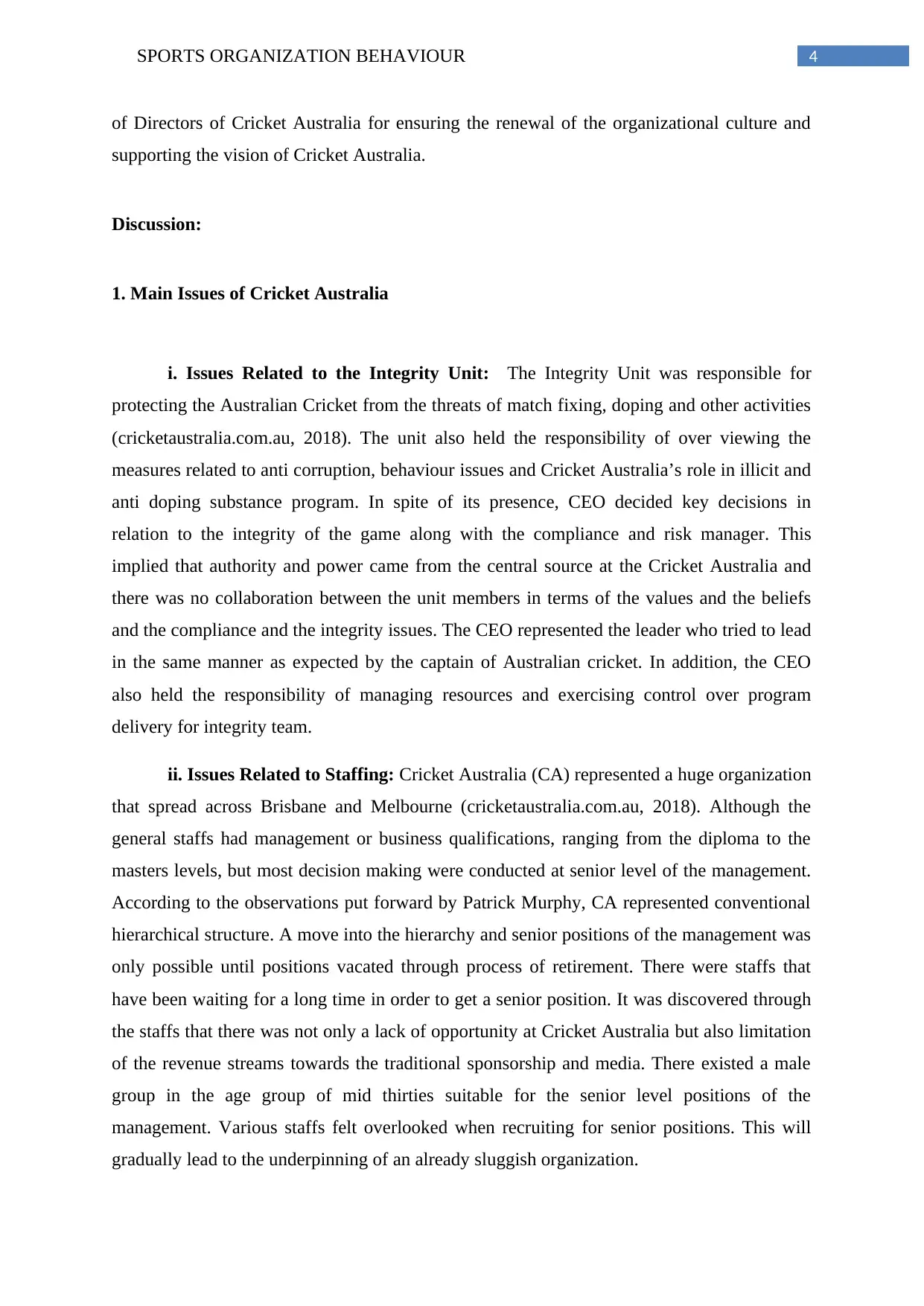
4SPORTS ORGANIZATION BEHAVIOUR
of Directors of Cricket Australia for ensuring the renewal of the organizational culture and
supporting the vision of Cricket Australia.
Discussion:
1. Main Issues of Cricket Australia
i. Issues Related to the Integrity Unit: The Integrity Unit was responsible for
protecting the Australian Cricket from the threats of match fixing, doping and other activities
(cricketaustralia.com.au, 2018). The unit also held the responsibility of over viewing the
measures related to anti corruption, behaviour issues and Cricket Australia’s role in illicit and
anti doping substance program. In spite of its presence, CEO decided key decisions in
relation to the integrity of the game along with the compliance and risk manager. This
implied that authority and power came from the central source at the Cricket Australia and
there was no collaboration between the unit members in terms of the values and the beliefs
and the compliance and the integrity issues. The CEO represented the leader who tried to lead
in the same manner as expected by the captain of Australian cricket. In addition, the CEO
also held the responsibility of managing resources and exercising control over program
delivery for integrity team.
ii. Issues Related to Staffing: Cricket Australia (CA) represented a huge organization
that spread across Brisbane and Melbourne (cricketaustralia.com.au, 2018). Although the
general staffs had management or business qualifications, ranging from the diploma to the
masters levels, but most decision making were conducted at senior level of the management.
According to the observations put forward by Patrick Murphy, CA represented conventional
hierarchical structure. A move into the hierarchy and senior positions of the management was
only possible until positions vacated through process of retirement. There were staffs that
have been waiting for a long time in order to get a senior position. It was discovered through
the staffs that there was not only a lack of opportunity at Cricket Australia but also limitation
of the revenue streams towards the traditional sponsorship and media. There existed a male
group in the age group of mid thirties suitable for the senior level positions of the
management. Various staffs felt overlooked when recruiting for senior positions. This will
gradually lead to the underpinning of an already sluggish organization.
of Directors of Cricket Australia for ensuring the renewal of the organizational culture and
supporting the vision of Cricket Australia.
Discussion:
1. Main Issues of Cricket Australia
i. Issues Related to the Integrity Unit: The Integrity Unit was responsible for
protecting the Australian Cricket from the threats of match fixing, doping and other activities
(cricketaustralia.com.au, 2018). The unit also held the responsibility of over viewing the
measures related to anti corruption, behaviour issues and Cricket Australia’s role in illicit and
anti doping substance program. In spite of its presence, CEO decided key decisions in
relation to the integrity of the game along with the compliance and risk manager. This
implied that authority and power came from the central source at the Cricket Australia and
there was no collaboration between the unit members in terms of the values and the beliefs
and the compliance and the integrity issues. The CEO represented the leader who tried to lead
in the same manner as expected by the captain of Australian cricket. In addition, the CEO
also held the responsibility of managing resources and exercising control over program
delivery for integrity team.
ii. Issues Related to Staffing: Cricket Australia (CA) represented a huge organization
that spread across Brisbane and Melbourne (cricketaustralia.com.au, 2018). Although the
general staffs had management or business qualifications, ranging from the diploma to the
masters levels, but most decision making were conducted at senior level of the management.
According to the observations put forward by Patrick Murphy, CA represented conventional
hierarchical structure. A move into the hierarchy and senior positions of the management was
only possible until positions vacated through process of retirement. There were staffs that
have been waiting for a long time in order to get a senior position. It was discovered through
the staffs that there was not only a lack of opportunity at Cricket Australia but also limitation
of the revenue streams towards the traditional sponsorship and media. There existed a male
group in the age group of mid thirties suitable for the senior level positions of the
management. Various staffs felt overlooked when recruiting for senior positions. This will
gradually lead to the underpinning of an already sluggish organization.
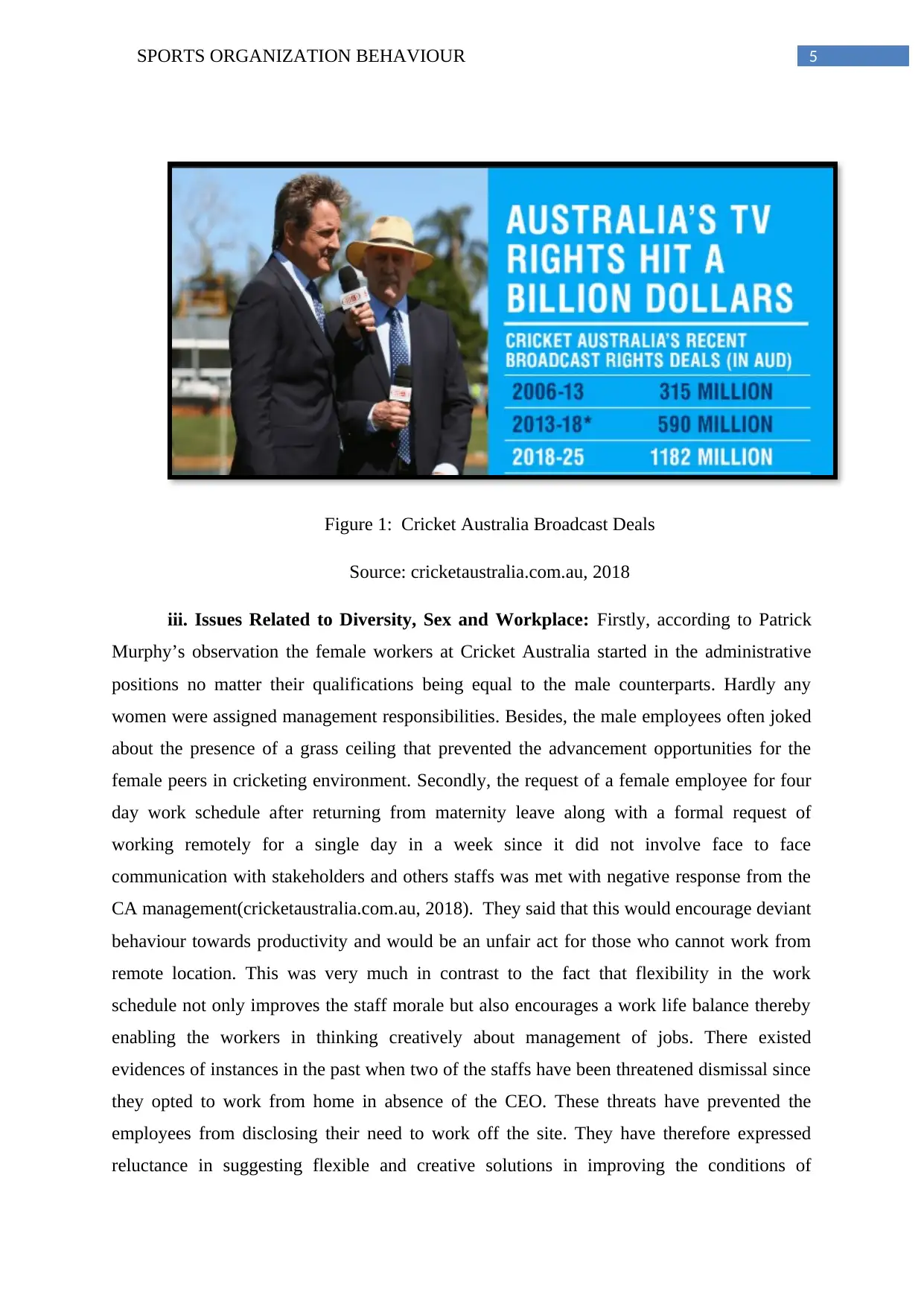
5SPORTS ORGANIZATION BEHAVIOUR
Figure 1: Cricket Australia Broadcast Deals
Source: cricketaustralia.com.au, 2018
iii. Issues Related to Diversity, Sex and Workplace: Firstly, according to Patrick
Murphy’s observation the female workers at Cricket Australia started in the administrative
positions no matter their qualifications being equal to the male counterparts. Hardly any
women were assigned management responsibilities. Besides, the male employees often joked
about the presence of a grass ceiling that prevented the advancement opportunities for the
female peers in cricketing environment. Secondly, the request of a female employee for four
day work schedule after returning from maternity leave along with a formal request of
working remotely for a single day in a week since it did not involve face to face
communication with stakeholders and others staffs was met with negative response from the
CA management(cricketaustralia.com.au, 2018). They said that this would encourage deviant
behaviour towards productivity and would be an unfair act for those who cannot work from
remote location. This was very much in contrast to the fact that flexibility in the work
schedule not only improves the staff morale but also encourages a work life balance thereby
enabling the workers in thinking creatively about management of jobs. There existed
evidences of instances in the past when two of the staffs have been threatened dismissal since
they opted to work from home in absence of the CEO. These threats have prevented the
employees from disclosing their need to work off the site. They have therefore expressed
reluctance in suggesting flexible and creative solutions in improving the conditions of
Figure 1: Cricket Australia Broadcast Deals
Source: cricketaustralia.com.au, 2018
iii. Issues Related to Diversity, Sex and Workplace: Firstly, according to Patrick
Murphy’s observation the female workers at Cricket Australia started in the administrative
positions no matter their qualifications being equal to the male counterparts. Hardly any
women were assigned management responsibilities. Besides, the male employees often joked
about the presence of a grass ceiling that prevented the advancement opportunities for the
female peers in cricketing environment. Secondly, the request of a female employee for four
day work schedule after returning from maternity leave along with a formal request of
working remotely for a single day in a week since it did not involve face to face
communication with stakeholders and others staffs was met with negative response from the
CA management(cricketaustralia.com.au, 2018). They said that this would encourage deviant
behaviour towards productivity and would be an unfair act for those who cannot work from
remote location. This was very much in contrast to the fact that flexibility in the work
schedule not only improves the staff morale but also encourages a work life balance thereby
enabling the workers in thinking creatively about management of jobs. There existed
evidences of instances in the past when two of the staffs have been threatened dismissal since
they opted to work from home in absence of the CEO. These threats have prevented the
employees from disclosing their need to work off the site. They have therefore expressed
reluctance in suggesting flexible and creative solutions in improving the conditions of
⊘ This is a preview!⊘
Do you want full access?
Subscribe today to unlock all pages.

Trusted by 1+ million students worldwide
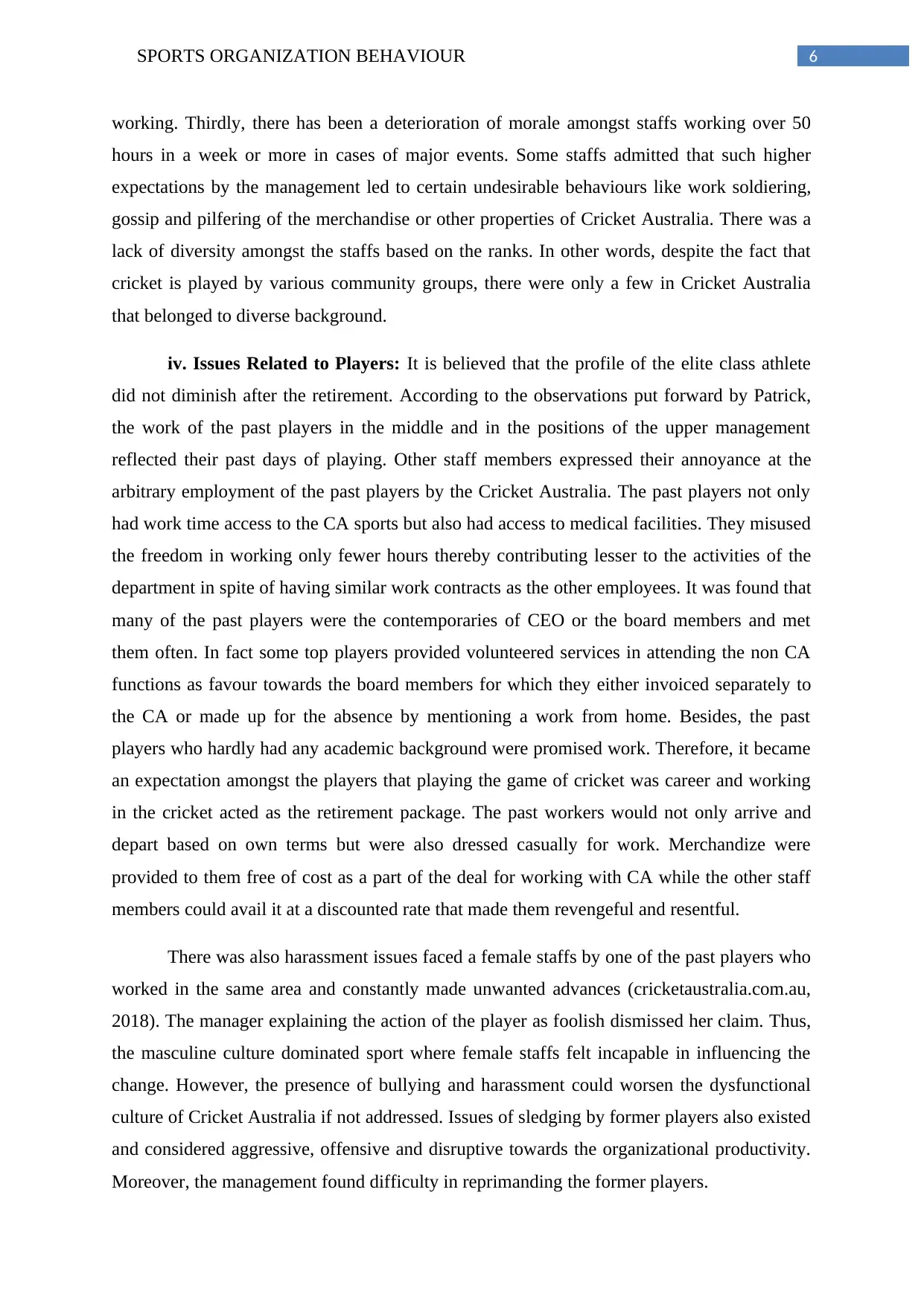
6SPORTS ORGANIZATION BEHAVIOUR
working. Thirdly, there has been a deterioration of morale amongst staffs working over 50
hours in a week or more in cases of major events. Some staffs admitted that such higher
expectations by the management led to certain undesirable behaviours like work soldiering,
gossip and pilfering of the merchandise or other properties of Cricket Australia. There was a
lack of diversity amongst the staffs based on the ranks. In other words, despite the fact that
cricket is played by various community groups, there were only a few in Cricket Australia
that belonged to diverse background.
iv. Issues Related to Players: It is believed that the profile of the elite class athlete
did not diminish after the retirement. According to the observations put forward by Patrick,
the work of the past players in the middle and in the positions of the upper management
reflected their past days of playing. Other staff members expressed their annoyance at the
arbitrary employment of the past players by the Cricket Australia. The past players not only
had work time access to the CA sports but also had access to medical facilities. They misused
the freedom in working only fewer hours thereby contributing lesser to the activities of the
department in spite of having similar work contracts as the other employees. It was found that
many of the past players were the contemporaries of CEO or the board members and met
them often. In fact some top players provided volunteered services in attending the non CA
functions as favour towards the board members for which they either invoiced separately to
the CA or made up for the absence by mentioning a work from home. Besides, the past
players who hardly had any academic background were promised work. Therefore, it became
an expectation amongst the players that playing the game of cricket was career and working
in the cricket acted as the retirement package. The past workers would not only arrive and
depart based on own terms but were also dressed casually for work. Merchandize were
provided to them free of cost as a part of the deal for working with CA while the other staff
members could avail it at a discounted rate that made them revengeful and resentful.
There was also harassment issues faced a female staffs by one of the past players who
worked in the same area and constantly made unwanted advances (cricketaustralia.com.au,
2018). The manager explaining the action of the player as foolish dismissed her claim. Thus,
the masculine culture dominated sport where female staffs felt incapable in influencing the
change. However, the presence of bullying and harassment could worsen the dysfunctional
culture of Cricket Australia if not addressed. Issues of sledging by former players also existed
and considered aggressive, offensive and disruptive towards the organizational productivity.
Moreover, the management found difficulty in reprimanding the former players.
working. Thirdly, there has been a deterioration of morale amongst staffs working over 50
hours in a week or more in cases of major events. Some staffs admitted that such higher
expectations by the management led to certain undesirable behaviours like work soldiering,
gossip and pilfering of the merchandise or other properties of Cricket Australia. There was a
lack of diversity amongst the staffs based on the ranks. In other words, despite the fact that
cricket is played by various community groups, there were only a few in Cricket Australia
that belonged to diverse background.
iv. Issues Related to Players: It is believed that the profile of the elite class athlete
did not diminish after the retirement. According to the observations put forward by Patrick,
the work of the past players in the middle and in the positions of the upper management
reflected their past days of playing. Other staff members expressed their annoyance at the
arbitrary employment of the past players by the Cricket Australia. The past players not only
had work time access to the CA sports but also had access to medical facilities. They misused
the freedom in working only fewer hours thereby contributing lesser to the activities of the
department in spite of having similar work contracts as the other employees. It was found that
many of the past players were the contemporaries of CEO or the board members and met
them often. In fact some top players provided volunteered services in attending the non CA
functions as favour towards the board members for which they either invoiced separately to
the CA or made up for the absence by mentioning a work from home. Besides, the past
players who hardly had any academic background were promised work. Therefore, it became
an expectation amongst the players that playing the game of cricket was career and working
in the cricket acted as the retirement package. The past workers would not only arrive and
depart based on own terms but were also dressed casually for work. Merchandize were
provided to them free of cost as a part of the deal for working with CA while the other staff
members could avail it at a discounted rate that made them revengeful and resentful.
There was also harassment issues faced a female staffs by one of the past players who
worked in the same area and constantly made unwanted advances (cricketaustralia.com.au,
2018). The manager explaining the action of the player as foolish dismissed her claim. Thus,
the masculine culture dominated sport where female staffs felt incapable in influencing the
change. However, the presence of bullying and harassment could worsen the dysfunctional
culture of Cricket Australia if not addressed. Issues of sledging by former players also existed
and considered aggressive, offensive and disruptive towards the organizational productivity.
Moreover, the management found difficulty in reprimanding the former players.
Paraphrase This Document
Need a fresh take? Get an instant paraphrase of this document with our AI Paraphraser
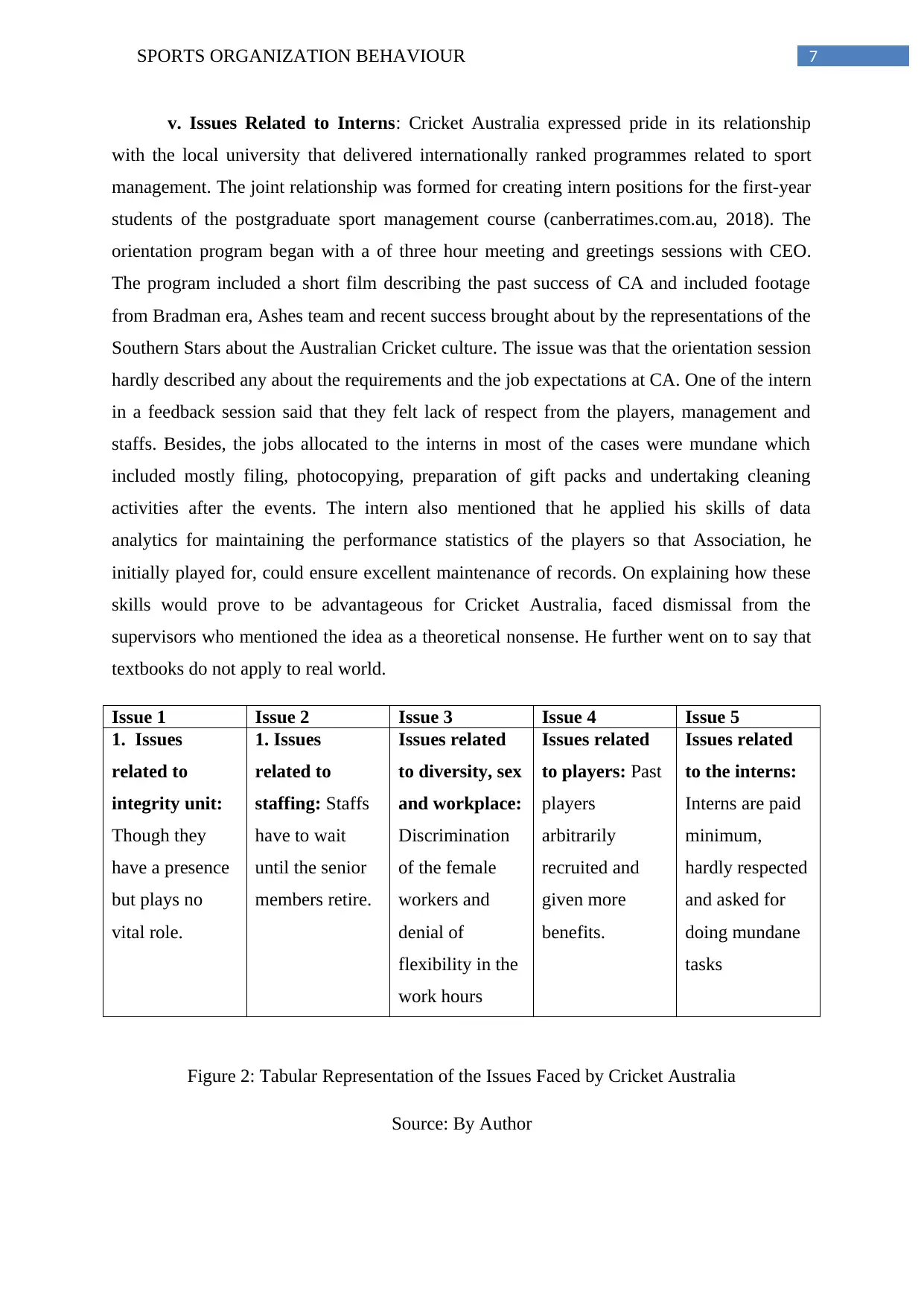
7SPORTS ORGANIZATION BEHAVIOUR
v. Issues Related to Interns: Cricket Australia expressed pride in its relationship
with the local university that delivered internationally ranked programmes related to sport
management. The joint relationship was formed for creating intern positions for the first-year
students of the postgraduate sport management course (canberratimes.com.au, 2018). The
orientation program began with a of three hour meeting and greetings sessions with CEO.
The program included a short film describing the past success of CA and included footage
from Bradman era, Ashes team and recent success brought about by the representations of the
Southern Stars about the Australian Cricket culture. The issue was that the orientation session
hardly described any about the requirements and the job expectations at CA. One of the intern
in a feedback session said that they felt lack of respect from the players, management and
staffs. Besides, the jobs allocated to the interns in most of the cases were mundane which
included mostly filing, photocopying, preparation of gift packs and undertaking cleaning
activities after the events. The intern also mentioned that he applied his skills of data
analytics for maintaining the performance statistics of the players so that Association, he
initially played for, could ensure excellent maintenance of records. On explaining how these
skills would prove to be advantageous for Cricket Australia, faced dismissal from the
supervisors who mentioned the idea as a theoretical nonsense. He further went on to say that
textbooks do not apply to real world.
Issue 1 Issue 2 Issue 3 Issue 4 Issue 5
1. Issues
related to
integrity unit:
Though they
have a presence
but plays no
vital role.
1. Issues
related to
staffing: Staffs
have to wait
until the senior
members retire.
Issues related
to diversity, sex
and workplace:
Discrimination
of the female
workers and
denial of
flexibility in the
work hours
Issues related
to players: Past
players
arbitrarily
recruited and
given more
benefits.
Issues related
to the interns:
Interns are paid
minimum,
hardly respected
and asked for
doing mundane
tasks
Figure 2: Tabular Representation of the Issues Faced by Cricket Australia
Source: By Author
v. Issues Related to Interns: Cricket Australia expressed pride in its relationship
with the local university that delivered internationally ranked programmes related to sport
management. The joint relationship was formed for creating intern positions for the first-year
students of the postgraduate sport management course (canberratimes.com.au, 2018). The
orientation program began with a of three hour meeting and greetings sessions with CEO.
The program included a short film describing the past success of CA and included footage
from Bradman era, Ashes team and recent success brought about by the representations of the
Southern Stars about the Australian Cricket culture. The issue was that the orientation session
hardly described any about the requirements and the job expectations at CA. One of the intern
in a feedback session said that they felt lack of respect from the players, management and
staffs. Besides, the jobs allocated to the interns in most of the cases were mundane which
included mostly filing, photocopying, preparation of gift packs and undertaking cleaning
activities after the events. The intern also mentioned that he applied his skills of data
analytics for maintaining the performance statistics of the players so that Association, he
initially played for, could ensure excellent maintenance of records. On explaining how these
skills would prove to be advantageous for Cricket Australia, faced dismissal from the
supervisors who mentioned the idea as a theoretical nonsense. He further went on to say that
textbooks do not apply to real world.
Issue 1 Issue 2 Issue 3 Issue 4 Issue 5
1. Issues
related to
integrity unit:
Though they
have a presence
but plays no
vital role.
1. Issues
related to
staffing: Staffs
have to wait
until the senior
members retire.
Issues related
to diversity, sex
and workplace:
Discrimination
of the female
workers and
denial of
flexibility in the
work hours
Issues related
to players: Past
players
arbitrarily
recruited and
given more
benefits.
Issues related
to the interns:
Interns are paid
minimum,
hardly respected
and asked for
doing mundane
tasks
Figure 2: Tabular Representation of the Issues Faced by Cricket Australia
Source: By Author
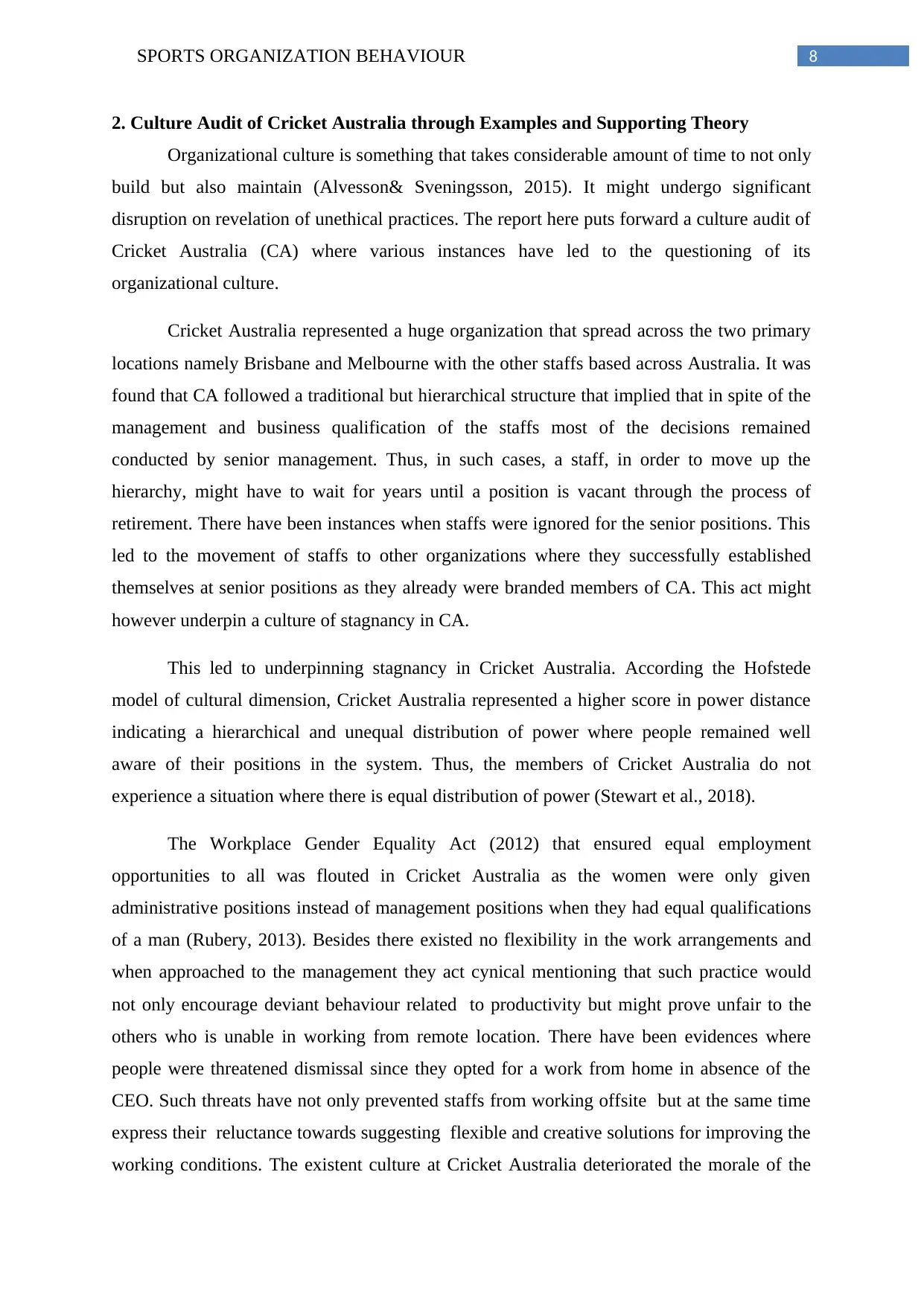
8SPORTS ORGANIZATION BEHAVIOUR
2. Culture Audit of Cricket Australia through Examples and Supporting Theory
Organizational culture is something that takes considerable amount of time to not only
build but also maintain (Alvesson& Sveningsson, 2015). It might undergo significant
disruption on revelation of unethical practices. The report here puts forward a culture audit of
Cricket Australia (CA) where various instances have led to the questioning of its
organizational culture.
Cricket Australia represented a huge organization that spread across the two primary
locations namely Brisbane and Melbourne with the other staffs based across Australia. It was
found that CA followed a traditional but hierarchical structure that implied that in spite of the
management and business qualification of the staffs most of the decisions remained
conducted by senior management. Thus, in such cases, a staff, in order to move up the
hierarchy, might have to wait for years until a position is vacant through the process of
retirement. There have been instances when staffs were ignored for the senior positions. This
led to the movement of staffs to other organizations where they successfully established
themselves at senior positions as they already were branded members of CA. This act might
however underpin a culture of stagnancy in CA.
This led to underpinning stagnancy in Cricket Australia. According the Hofstede
model of cultural dimension, Cricket Australia represented a higher score in power distance
indicating a hierarchical and unequal distribution of power where people remained well
aware of their positions in the system. Thus, the members of Cricket Australia do not
experience a situation where there is equal distribution of power (Stewart et al., 2018).
The Workplace Gender Equality Act (2012) that ensured equal employment
opportunities to all was flouted in Cricket Australia as the women were only given
administrative positions instead of management positions when they had equal qualifications
of a man (Rubery, 2013). Besides there existed no flexibility in the work arrangements and
when approached to the management they act cynical mentioning that such practice would
not only encourage deviant behaviour related to productivity but might prove unfair to the
others who is unable in working from remote location. There have been evidences where
people were threatened dismissal since they opted for a work from home in absence of the
CEO. Such threats have not only prevented staffs from working offsite but at the same time
express their reluctance towards suggesting flexible and creative solutions for improving the
working conditions. The existent culture at Cricket Australia deteriorated the morale of the
2. Culture Audit of Cricket Australia through Examples and Supporting Theory
Organizational culture is something that takes considerable amount of time to not only
build but also maintain (Alvesson& Sveningsson, 2015). It might undergo significant
disruption on revelation of unethical practices. The report here puts forward a culture audit of
Cricket Australia (CA) where various instances have led to the questioning of its
organizational culture.
Cricket Australia represented a huge organization that spread across the two primary
locations namely Brisbane and Melbourne with the other staffs based across Australia. It was
found that CA followed a traditional but hierarchical structure that implied that in spite of the
management and business qualification of the staffs most of the decisions remained
conducted by senior management. Thus, in such cases, a staff, in order to move up the
hierarchy, might have to wait for years until a position is vacant through the process of
retirement. There have been instances when staffs were ignored for the senior positions. This
led to the movement of staffs to other organizations where they successfully established
themselves at senior positions as they already were branded members of CA. This act might
however underpin a culture of stagnancy in CA.
This led to underpinning stagnancy in Cricket Australia. According the Hofstede
model of cultural dimension, Cricket Australia represented a higher score in power distance
indicating a hierarchical and unequal distribution of power where people remained well
aware of their positions in the system. Thus, the members of Cricket Australia do not
experience a situation where there is equal distribution of power (Stewart et al., 2018).
The Workplace Gender Equality Act (2012) that ensured equal employment
opportunities to all was flouted in Cricket Australia as the women were only given
administrative positions instead of management positions when they had equal qualifications
of a man (Rubery, 2013). Besides there existed no flexibility in the work arrangements and
when approached to the management they act cynical mentioning that such practice would
not only encourage deviant behaviour related to productivity but might prove unfair to the
others who is unable in working from remote location. There have been evidences where
people were threatened dismissal since they opted for a work from home in absence of the
CEO. Such threats have not only prevented staffs from working offsite but at the same time
express their reluctance towards suggesting flexible and creative solutions for improving the
working conditions. The existent culture at Cricket Australia deteriorated the morale of the
⊘ This is a preview!⊘
Do you want full access?
Subscribe today to unlock all pages.

Trusted by 1+ million students worldwide
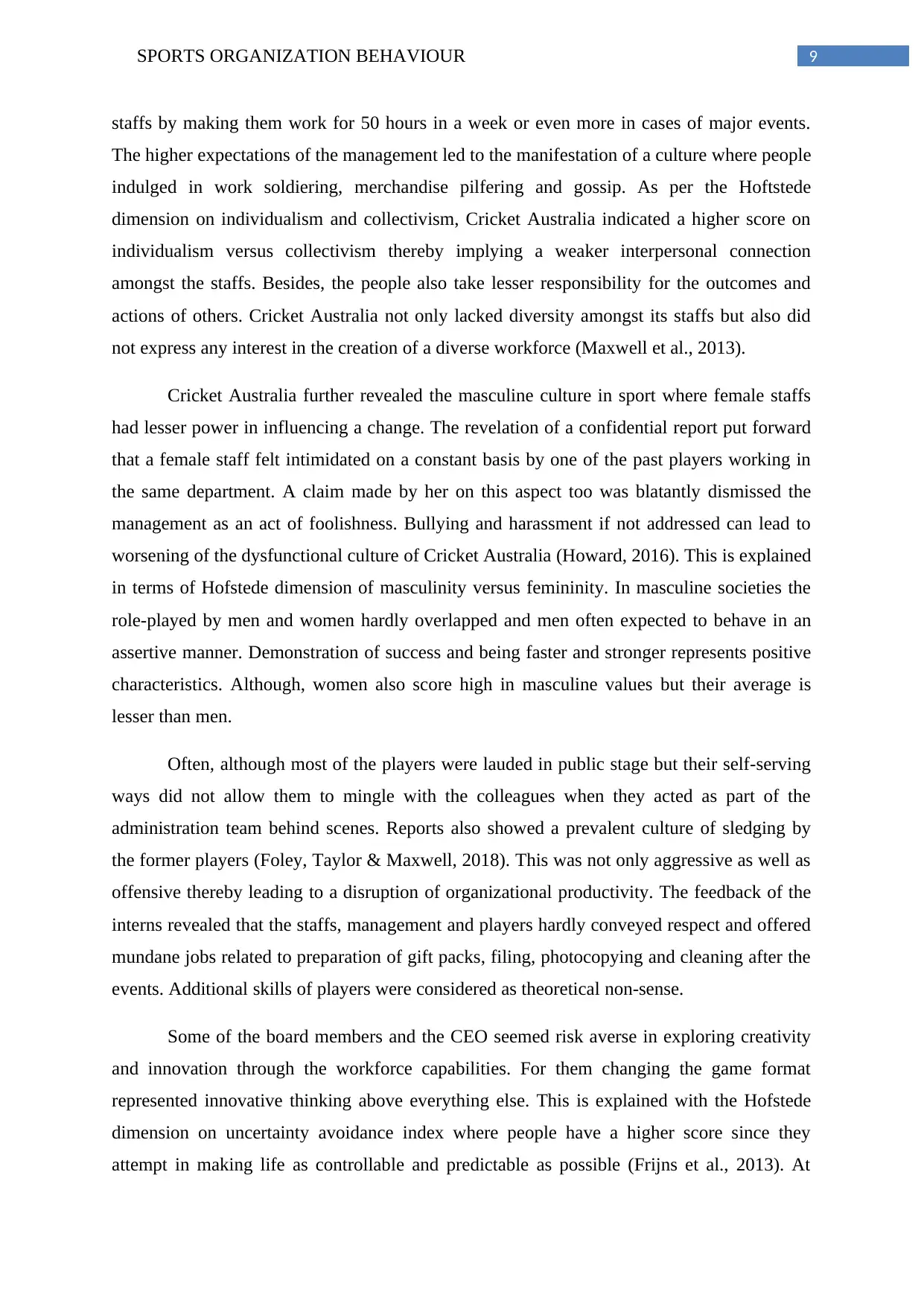
9SPORTS ORGANIZATION BEHAVIOUR
staffs by making them work for 50 hours in a week or even more in cases of major events.
The higher expectations of the management led to the manifestation of a culture where people
indulged in work soldiering, merchandise pilfering and gossip. As per the Hoftstede
dimension on individualism and collectivism, Cricket Australia indicated a higher score on
individualism versus collectivism thereby implying a weaker interpersonal connection
amongst the staffs. Besides, the people also take lesser responsibility for the outcomes and
actions of others. Cricket Australia not only lacked diversity amongst its staffs but also did
not express any interest in the creation of a diverse workforce (Maxwell et al., 2013).
Cricket Australia further revealed the masculine culture in sport where female staffs
had lesser power in influencing a change. The revelation of a confidential report put forward
that a female staff felt intimidated on a constant basis by one of the past players working in
the same department. A claim made by her on this aspect too was blatantly dismissed the
management as an act of foolishness. Bullying and harassment if not addressed can lead to
worsening of the dysfunctional culture of Cricket Australia (Howard, 2016). This is explained
in terms of Hofstede dimension of masculinity versus femininity. In masculine societies the
role-played by men and women hardly overlapped and men often expected to behave in an
assertive manner. Demonstration of success and being faster and stronger represents positive
characteristics. Although, women also score high in masculine values but their average is
lesser than men.
Often, although most of the players were lauded in public stage but their self-serving
ways did not allow them to mingle with the colleagues when they acted as part of the
administration team behind scenes. Reports also showed a prevalent culture of sledging by
the former players (Foley, Taylor & Maxwell, 2018). This was not only aggressive as well as
offensive thereby leading to a disruption of organizational productivity. The feedback of the
interns revealed that the staffs, management and players hardly conveyed respect and offered
mundane jobs related to preparation of gift packs, filing, photocopying and cleaning after the
events. Additional skills of players were considered as theoretical non-sense.
Some of the board members and the CEO seemed risk averse in exploring creativity
and innovation through the workforce capabilities. For them changing the game format
represented innovative thinking above everything else. This is explained with the Hofstede
dimension on uncertainty avoidance index where people have a higher score since they
attempt in making life as controllable and predictable as possible (Frijns et al., 2013). At
staffs by making them work for 50 hours in a week or even more in cases of major events.
The higher expectations of the management led to the manifestation of a culture where people
indulged in work soldiering, merchandise pilfering and gossip. As per the Hoftstede
dimension on individualism and collectivism, Cricket Australia indicated a higher score on
individualism versus collectivism thereby implying a weaker interpersonal connection
amongst the staffs. Besides, the people also take lesser responsibility for the outcomes and
actions of others. Cricket Australia not only lacked diversity amongst its staffs but also did
not express any interest in the creation of a diverse workforce (Maxwell et al., 2013).
Cricket Australia further revealed the masculine culture in sport where female staffs
had lesser power in influencing a change. The revelation of a confidential report put forward
that a female staff felt intimidated on a constant basis by one of the past players working in
the same department. A claim made by her on this aspect too was blatantly dismissed the
management as an act of foolishness. Bullying and harassment if not addressed can lead to
worsening of the dysfunctional culture of Cricket Australia (Howard, 2016). This is explained
in terms of Hofstede dimension of masculinity versus femininity. In masculine societies the
role-played by men and women hardly overlapped and men often expected to behave in an
assertive manner. Demonstration of success and being faster and stronger represents positive
characteristics. Although, women also score high in masculine values but their average is
lesser than men.
Often, although most of the players were lauded in public stage but their self-serving
ways did not allow them to mingle with the colleagues when they acted as part of the
administration team behind scenes. Reports also showed a prevalent culture of sledging by
the former players (Foley, Taylor & Maxwell, 2018). This was not only aggressive as well as
offensive thereby leading to a disruption of organizational productivity. The feedback of the
interns revealed that the staffs, management and players hardly conveyed respect and offered
mundane jobs related to preparation of gift packs, filing, photocopying and cleaning after the
events. Additional skills of players were considered as theoretical non-sense.
Some of the board members and the CEO seemed risk averse in exploring creativity
and innovation through the workforce capabilities. For them changing the game format
represented innovative thinking above everything else. This is explained with the Hofstede
dimension on uncertainty avoidance index where people have a higher score since they
attempt in making life as controllable and predictable as possible (Frijns et al., 2013). At
Paraphrase This Document
Need a fresh take? Get an instant paraphrase of this document with our AI Paraphraser
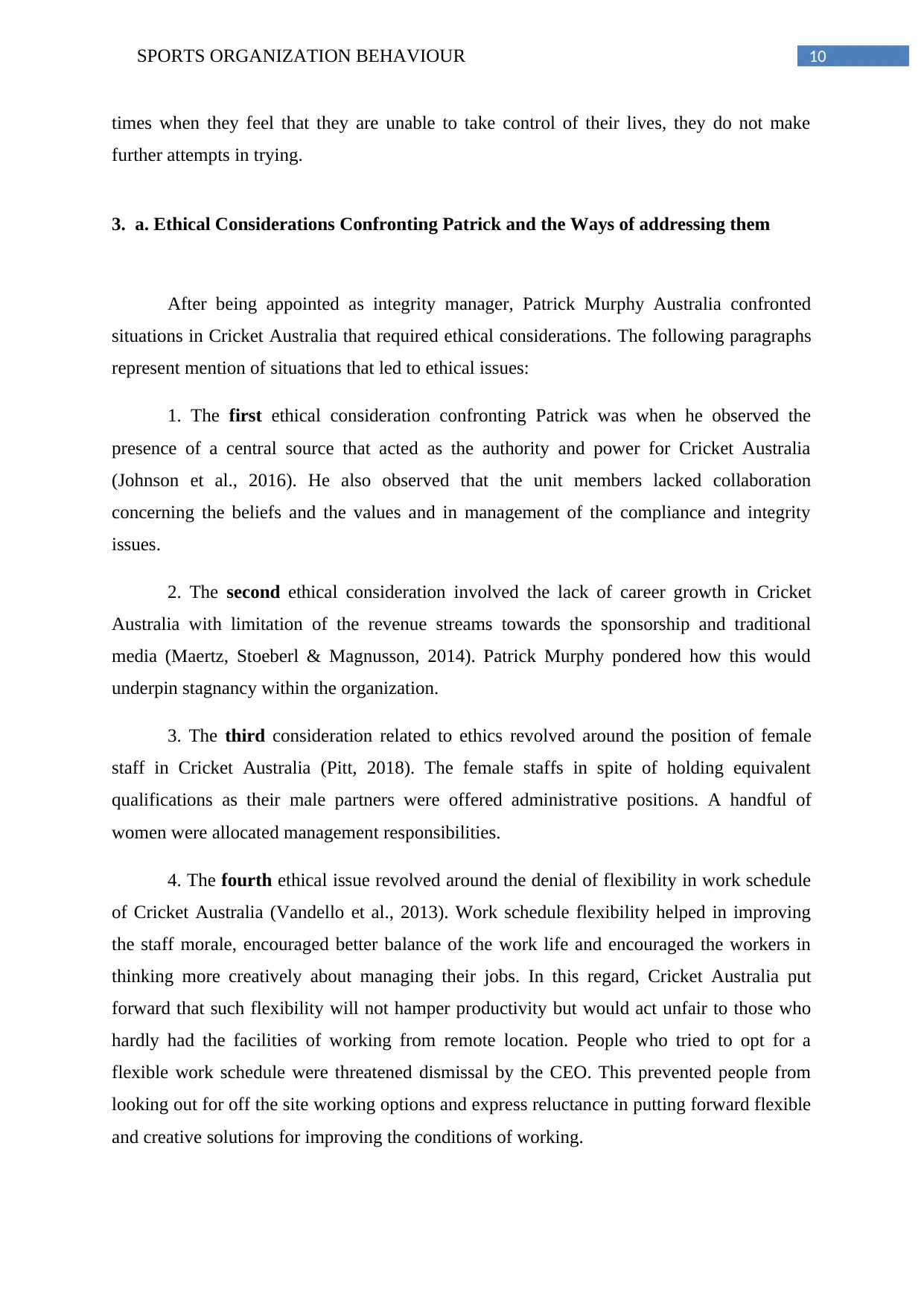
10SPORTS ORGANIZATION BEHAVIOUR
times when they feel that they are unable to take control of their lives, they do not make
further attempts in trying.
3. a. Ethical Considerations Confronting Patrick and the Ways of addressing them
After being appointed as integrity manager, Patrick Murphy Australia confronted
situations in Cricket Australia that required ethical considerations. The following paragraphs
represent mention of situations that led to ethical issues:
1. The first ethical consideration confronting Patrick was when he observed the
presence of a central source that acted as the authority and power for Cricket Australia
(Johnson et al., 2016). He also observed that the unit members lacked collaboration
concerning the beliefs and the values and in management of the compliance and integrity
issues.
2. The second ethical consideration involved the lack of career growth in Cricket
Australia with limitation of the revenue streams towards the sponsorship and traditional
media (Maertz, Stoeberl & Magnusson, 2014). Patrick Murphy pondered how this would
underpin stagnancy within the organization.
3. The third consideration related to ethics revolved around the position of female
staff in Cricket Australia (Pitt, 2018). The female staffs in spite of holding equivalent
qualifications as their male partners were offered administrative positions. A handful of
women were allocated management responsibilities.
4. The fourth ethical issue revolved around the denial of flexibility in work schedule
of Cricket Australia (Vandello et al., 2013). Work schedule flexibility helped in improving
the staff morale, encouraged better balance of the work life and encouraged the workers in
thinking more creatively about managing their jobs. In this regard, Cricket Australia put
forward that such flexibility will not hamper productivity but would act unfair to those who
hardly had the facilities of working from remote location. People who tried to opt for a
flexible work schedule were threatened dismissal by the CEO. This prevented people from
looking out for off the site working options and express reluctance in putting forward flexible
and creative solutions for improving the conditions of working.
times when they feel that they are unable to take control of their lives, they do not make
further attempts in trying.
3. a. Ethical Considerations Confronting Patrick and the Ways of addressing them
After being appointed as integrity manager, Patrick Murphy Australia confronted
situations in Cricket Australia that required ethical considerations. The following paragraphs
represent mention of situations that led to ethical issues:
1. The first ethical consideration confronting Patrick was when he observed the
presence of a central source that acted as the authority and power for Cricket Australia
(Johnson et al., 2016). He also observed that the unit members lacked collaboration
concerning the beliefs and the values and in management of the compliance and integrity
issues.
2. The second ethical consideration involved the lack of career growth in Cricket
Australia with limitation of the revenue streams towards the sponsorship and traditional
media (Maertz, Stoeberl & Magnusson, 2014). Patrick Murphy pondered how this would
underpin stagnancy within the organization.
3. The third consideration related to ethics revolved around the position of female
staff in Cricket Australia (Pitt, 2018). The female staffs in spite of holding equivalent
qualifications as their male partners were offered administrative positions. A handful of
women were allocated management responsibilities.
4. The fourth ethical issue revolved around the denial of flexibility in work schedule
of Cricket Australia (Vandello et al., 2013). Work schedule flexibility helped in improving
the staff morale, encouraged better balance of the work life and encouraged the workers in
thinking more creatively about managing their jobs. In this regard, Cricket Australia put
forward that such flexibility will not hamper productivity but would act unfair to those who
hardly had the facilities of working from remote location. People who tried to opt for a
flexible work schedule were threatened dismissal by the CEO. This prevented people from
looking out for off the site working options and express reluctance in putting forward flexible
and creative solutions for improving the conditions of working.

11SPORTS ORGANIZATION BEHAVIOUR
5. The fifth ethical consideration issue involved the deterioration of the employee
morale by making them work for around 50 hours per week and even more during major
events (Crompton, 2015). The higher expectations of the management led to improper
employee behaviour that included stealing of merchandize, work soldiering and gossip. These
unethical habits needed consideration for better organizational performance (Hargreaves
Boyle & Harris, 2014).
6. The sixth ethical issue involved the lack of recognition of diversity in Cricket
Australia that might have enabled the company in keeping up with the diversity laws or the
ethical standards (Van, Ginkel & Homan, 2013).
7. The seventh confronting ethical consideration was the arbitrary favour provided to
the past players for the in matters of employment and treatment by Cricket Australia
(Nauright & Mangan, 2013) These players were allowed to have work time access in Cricket
Australia along with medical facilities. These players further demanded rehabilitation by
Cricket Australia until the end since some of them faced injury while representing the state so
they should be. Players on the other hand used the freedom in working lesser hours and
thereby contributing lesser to the activities of the department despite having same working
contracts. Besides, these players also attended the non-Cricket Australia functions as favour
to the board members thereby providing a separate invoice to the Cricket Australia or by
passing the service off as an absence marked by an option of work from home. Further, the
past players did not comply with the employment procedures like the other paid staffs.
8. The eighth confronting ethical issue dealt with the harassment faced by the women
employees and the act of sledging by some of the former players that were not only
aggressive, offensive and disruption of the organizational productivity (Ryan, 2017). The
integrity manager observed that the senior management found difficulty in reprimanding the
former players and there existed no plan for overcoming the behavioural issues.
9. The ninth confronting ethical issue involved the interns who were allowed paid
employment during their school semester. This led to the violation of the law that stated that
the international students were not eligible for paid employment of over 40 hours during a
fortnight while they are still in school (Maertz , Stoeberl, & Marks, 2014).
Partrick Murphy might address the ethical confrontations in the following manner
(Weiss, 2014):
5. The fifth ethical consideration issue involved the deterioration of the employee
morale by making them work for around 50 hours per week and even more during major
events (Crompton, 2015). The higher expectations of the management led to improper
employee behaviour that included stealing of merchandize, work soldiering and gossip. These
unethical habits needed consideration for better organizational performance (Hargreaves
Boyle & Harris, 2014).
6. The sixth ethical issue involved the lack of recognition of diversity in Cricket
Australia that might have enabled the company in keeping up with the diversity laws or the
ethical standards (Van, Ginkel & Homan, 2013).
7. The seventh confronting ethical consideration was the arbitrary favour provided to
the past players for the in matters of employment and treatment by Cricket Australia
(Nauright & Mangan, 2013) These players were allowed to have work time access in Cricket
Australia along with medical facilities. These players further demanded rehabilitation by
Cricket Australia until the end since some of them faced injury while representing the state so
they should be. Players on the other hand used the freedom in working lesser hours and
thereby contributing lesser to the activities of the department despite having same working
contracts. Besides, these players also attended the non-Cricket Australia functions as favour
to the board members thereby providing a separate invoice to the Cricket Australia or by
passing the service off as an absence marked by an option of work from home. Further, the
past players did not comply with the employment procedures like the other paid staffs.
8. The eighth confronting ethical issue dealt with the harassment faced by the women
employees and the act of sledging by some of the former players that were not only
aggressive, offensive and disruption of the organizational productivity (Ryan, 2017). The
integrity manager observed that the senior management found difficulty in reprimanding the
former players and there existed no plan for overcoming the behavioural issues.
9. The ninth confronting ethical issue involved the interns who were allowed paid
employment during their school semester. This led to the violation of the law that stated that
the international students were not eligible for paid employment of over 40 hours during a
fortnight while they are still in school (Maertz , Stoeberl, & Marks, 2014).
Partrick Murphy might address the ethical confrontations in the following manner
(Weiss, 2014):
⊘ This is a preview!⊘
Do you want full access?
Subscribe today to unlock all pages.

Trusted by 1+ million students worldwide
1 out of 24
Related Documents
Your All-in-One AI-Powered Toolkit for Academic Success.
+13062052269
info@desklib.com
Available 24*7 on WhatsApp / Email
![[object Object]](/_next/static/media/star-bottom.7253800d.svg)
Unlock your academic potential
Copyright © 2020–2025 A2Z Services. All Rights Reserved. Developed and managed by ZUCOL.




